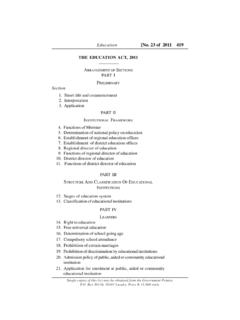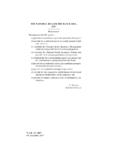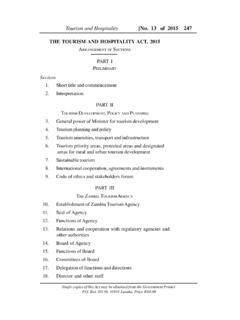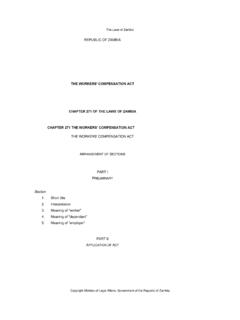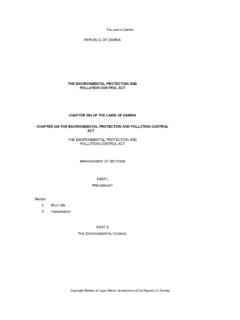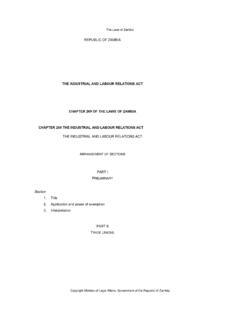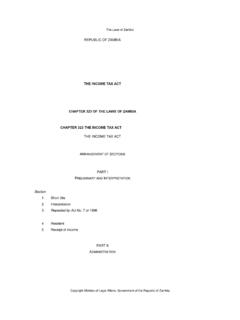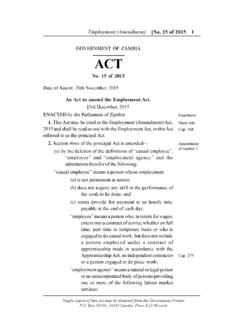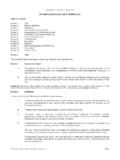Transcription of L A S S E MBLY
1 PUBLIC FINANCIAL MANAGEMENT HANDBOOK for Members of Parliament and StaffiPUBLIC FINANCIAL MANAGEMENT HANDBOOKfor Members of Parliament and StaffRepublic of ZambiaSupport to the National Assembly of Zambia Project Component of the European Union Support to Public Financial Management, Accountability and Statistics Programme. October 2017 NATIONAL ASSEMBLY OF ZAMBIAPUBLIC FINANCIAL MANAGEMENT HANDBOOK for Members of Parliament and StaffiThe National Assembly of Zambia performs four core functions, namely law-making, representation, budget scrutiny and approval, and oversight.
2 Its authority is derived from the Constitution of Zambia (Amendment) Act No. 2, 2016, which states that the representation of the will of the people and the legislative and oversight authority of the Republic are vested in and exercised by the National Assembly has the formal powers to keep the Executive accountable for its actions and policies, including its management of public financial resources, the challenge is to use this mandate to effectively ensure that the Executive adheres to prudent public financial management principles and fiscal policy targets.
3 Including maintaining aggregate fiscal discipline and ensuring that public resources are used equitably, efficiently, effectively and accountably. The National Assembly has for some time been undertaking reforms in order to strengthen the performance of its constitutional functions, and its present Strategic Plan 2015-2019 sets out strategic objectives for a further strengthening of its capacity within its core functions. As part of this process, the National Assembly is implementing the European Union s Support to the National Assembly of Zambia Project, which aims at strengthening the ability of the National Assembly of Zambia to perform its role as the apex of public financial management and budget accountability purpose of this Handbook, developed under the auspices of the European Union Project, is to provide a toolkit for the strengthening of the National Assembly in the performance of its mandate in public financial management.
4 It provides a comprehensive introduction to the concept, objectives and scope of public financial management and serves as a reference and self-training manual for Members of Parliament and Staff of the National Assembly on issues relevant to their specific functions. Moreover, the Handbook serves as a framework for the design of future capacity building interventions initiated by the National Assembly for both Members and Handbook does not represent an assessment of the effectiveness of the country s current financial management setup nor operational performance.
5 Any financial management system is undergoing periodic reviews overtime to improve its effectiveness. The Zambian PFM system is no exception. Some parts of the system works better than others. However, the National Assembly recognises that Government has embarked on series of reforms aiming at improving the efficiency, effectiveness, transparency and accountability of the current system. The ongoing implementation of the Treasury Single Account; the Integrated Financial Management Information System; Output-Based Budgeting ; the expected planning and budgeting legislation and the revisions to the Public Finance Act are examples of the reforms.
6 Let me take this opportunity to thank all the stakeholders - the academia, governmental and non-governmental think tanks, national public financial management experts and practitioners and National Assembly staff members - for their valuable contributions and lively participation during the course of developing the Handbook. Let me also take this opportunity to thank the Ministry of Finance for taking time to provide input and for supporting the publishing of the document. Finally, I extend my gratitude to the European Union without whose support this Handbook would have been a challenge to write and publish.
7 It is my hope that Members and Staff of Parliament will employ the Handbook as an essential aid in public financial management Hon. Justice Dr. Patrick Matibini, SC., MP Speaker of the National Assembly of ZambiaForewordiiPUBLIC FINANCIAL MANAGEMENT HANDBOOK for Members of Parliament and StaffForeword iAcronyms ivIntroduction 1 MODULE I. INTRODUCTION AND BACKGROUND TO PUBLIC FINANCIAL MANAGEMENT 3 Chapter 1. The meaning, objectives and content of public financial management 5 Chapter 2. Fiscal decentralisation and the fiscal relationship between the Central Government, Parliament and sub-national governments 13 Chapter 3.
8 Good financial governance and political economy 21 MODULE II. INSTITUTIONAL, POLICY AND LEGAL FRAMEWORK 29 Chapter 4. Legislative and regulatory framework for managing public finances 31 Chapter 5. The national integrated planning and budgeting framework 37 Chapter 6. Purpose and structure of public budgets 41 Chapter 7. Government accounting and reporting standards and practices 49 Chapter 8. Key players and their roles and responsibilities in PFM 59 Chapter 9. Parliament s role during the budget cycle 67 MODULE III.
9 BUDGET FORMULATION STAGE 75 Chapter 10. Choice of budget methods 77 Chapter 11. The role of communities in the planning and budgeting process, including project identification at community and constituency levels and MPs role in the process 83 Chapter 12. The national budget preparation process 91 Chapter 13. Resource mobilisation and design of revenue systems 97 Chapter 14. Understanding the Green Paper (Medium-Term Expenditure Framework) 105 MODULE IV. BUDGET SCRUTINY AND APPROVAL STAGE 111 Chapter 15. The coverage and classification of the budget (understanding the structure and contents of the Yellow Book) 113 Chapter 16.
10 Policy and budget analysis as a tool to inform the political debate and decision making 127 Chapter 17. Analysis of the linkages between revenues, sector policies and budget allocations, and between economic growth and poverty reduction 135 Chapter 18. Analysis of the relationship between fiscal and economic policies and variables 147 Chapter 19. Liabilities and assets management 155 Chapter 20. Checklist for political scrutiny of the Green Paper and the Yellow Book 161 Table of ContentsPUBLIC FINANCIAL MANAGEMENT HANDBOOK for Members of Parliament and StaffiiiMODULE V.
